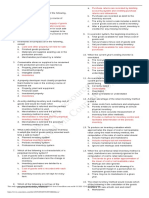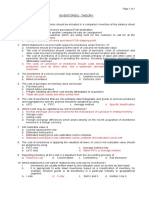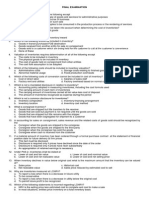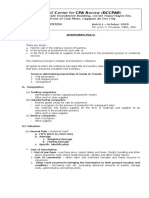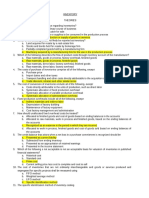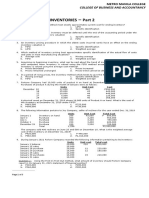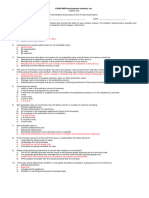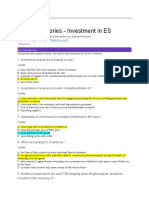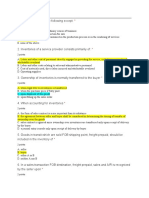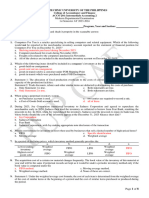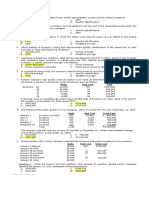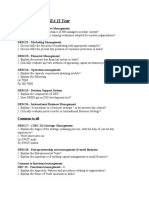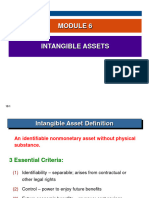1.
Sales in which the buyer is not yet ready to take delivery but does take title are
known as:
a. Barter sales
b. Bill and hold sales
c. Lay away sales
d. Sales with buyback
2. In a period of falling prices, which inventory method generally provides the lowest
amount of net income?
a. Weighted average
b. Moving average
c. FIFO
d. Specific identification
3. The amount of any write down of inventory to net realizable value and all losses
of inventory shall be:
a. Recognized as operating expense in the period the write down or loss
occurs
b. Recognized as other expense in the period the write down or loss occurs
c. Recognized as component of cost of goods sold in the period the write down
or loss occurs
d. Deferred until the related inventory is sold
4. LCNRV of inventory:
a. Is always either the net realizable or cost
b. Must be equal to net realizable value
c. May sometimes be less than net realizable value
d. Must be equal to estimated selling price less cost to complete
5. The cost of inventories that are not ordinarily interchangeable and goods
produced and segregated for specific projects shall be measured using:
a. FIFO
b. Average method
c. LIFO
d. Specific identification
6. Under the retail inventory method, freight in would be included in the calculation
of the goods available for sale for which of the following?
COST RETAIL
a. No No
b. No Yes
c. Yes No
d. Yes YES
7. According to the net method, which of the following items should be included in
the cost of inventory?
a. Freight costs = YES; Purchase discounts not taken = NO
b. Freight costs = YES; Purchase discounts not taken = YES
c. Freight costs = NO; Purchase discounts not taken = YES
� d. Freight costs = NO; Purchase discounts not taken = NO
8. Assume that the items of inventory that were purchased or produced first are
sold first, and consequently the items remaining in inventory at the end of the
period are those most recently purchased or produced:
a. FIFO
b. LIFO
c. Weighted average method
d. Specific identification
9. Inventories shall be measured at:
a. Cost
b. Net realizable value
c. Lower of cost and net realizable value
d. Higher of cost and net realizable value
10. The gross profit method of estimating ending inventory may be used for all of the
following, except:
a. Internal as well as external interim reports
b. Internal as well as external year-end reports
c. Estimate of inventory destroyed by fire or other casualty
d. Rough test of validity of an inventory cost determined under the periodic or
perpetual system
11. Sales where the goods are delivered only when the buyer makes final payment
are called:
a. Bill and hold sales
b. Sales subject to installation or inspection
c. Consignment sales
d. Lay away sales
12. Which of the following inventory method reports most closely the current cost
inventory?
a. FIFO
b. LIFO
c. Weighted average
d. Specific identification
13. The retail method has been used by a retail department store during its first year
of operations. As of the end of year, compare (A) the markdowns with (B) the
markdown cancellation:
a. A will be equal to B
b. A will be less than or equal to B
c. A will be greater than or equal to B
d. A cannot be equal to B
14. When determining the net realizable value of inventory, estimates must be made
of the following:
I. Estimated costs of completion
II. Expected replacement cost
�III. Expected normal profit margin
IV. Estimated selling price
a. I, II, III, and IV
b. I, II, III only
c. I and IV only
d. I, III, and IV only
15. Under PAS 2, Inventories, which of the following costs would generally be
excluded from the cost of inventory?
a. Freight in
b. Storage and warehousing costs
c. Import duties
d. Insurance while goods are in transit
16. Lower of cost or net realizable value
a. Is most conservative is applied to the total inventory
b. Is most conservative if applied to major categories of inventory
c. Is most conservative if applied to individual items of inventory
d. Must be applied to major categories for taxes
17. The cost of inventory is the sum of:
a. Costs of purchase and costs of conversion
b. Direct costs, indirect costs, and other costs (allocated production
overheads)
c. Cost of purchase, costs of conversion (allocated production overheads)
and other costs incurred in bringing the inventory to their present location
and condition
d. Cost of purchase only
18. A firm using the perpetual inventory method returned defective merchandise
costing P5,000 to one of its suppliers. The entry to record this transaction will
include a debit to
a. Accounts receivable
b. Inventory
c. Purchase returns and allowances
d. Accounts payable
19. What is a consigned inventory?
a. Goods that are shipped and title transfer to the consignee.
b. Goods that are sold but payment is not required until the goods are sold
c. Goods that are shipped but title remains with the consignor
d. Goods that have been segregated for shipment to a customer
20. Which of the following inventory estimating procedure is allowed even for annual
reporting purposes?
GPM RIM
a. Allowed Allowed
b. Not Allowed Allowed
c. Allowed Not Allowed
d. Not Allowed Not Allowed
�21. Inventories are assets (Choose the incorrect one):
a. Held for sale in the ordinary course of business
b. In the process of production for sale
c. In the form of materials or supplies to be consumed in the production
process or in the rendering of services
d. Held for use in the production or supply of goods and services
22. The credit balance that arises when a loss on a purchase commitment is
recognized should be:
a. Presented as a current liability
b. Subtracted from ending inventory
c. Presented as an appropriation of retained earnings
d. Presented in the income statement
23. The gross profit method of estimating inventory would not be useful when:
a. A periodic system is in use and inventories are required for interim
statements
b. Inventories have been destroyed or lost by fire, theft, or other casualty,
and the specific data required for the inventory valuation are not available
c. There is a significant change in the mix of products being sold
d. The relationship between gross profit and sales remain stable over time
24. Which of the following cost flow assumptions is used for inventory when an
entity build townhouses?
a. FIFO
b. Specific identification
c. Weighted average
d. Any of these cost flow assumption
25. An entity is a large manufacturer of machines. A major customer has placed an
order for a special machine for which it has given a deposit to the entity. The parties
have agreed on a price for the machine. As per the terms of the sale agreement, it is
free on board contract and the titles passes to the buyer when the goods are loaded
into the ship at the port. When should the revenue be recognized by the entity?
a. When the customer orders the machine
b. When the deposit is received
c. When the machine is loaded at the port
d. When the machine has been received by the customer



